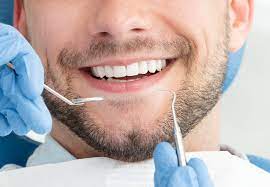Teeth polishing for stain removal is a popular dental treatment designed to enhance the appearance of your smile by removing surface stains and discoloration. If you’ve noticed that your teeth are dull or yellowish, teeth polishing might be the solution to brighten your smile. However, you may be wondering if teeth polishing is effective in truly eliminating stains and improving overall dental aesthetics. This article explores how Teeth Polishing & Scaling works and its effectiveness in stain removal.
What Is Teeth Polishing?
Teeth polishing is a cosmetic dental procedure that involves smoothing the surface of your teeth using a gritty paste and a polishing tool. This process removes plaque, surface stains, and debris that can accumulate on your teeth from food, drinks, or habits like smoking. It is typically performed after a dental cleaning to leave your teeth looking shiny and fresh.
- Stain removal: Polishing helps remove surface stains caused by coffee, tea, tobacco, and other staining agents
- Smooths tooth surfaces: It smoothens the enamel, making it harder for plaque and stains to accumulate
- Enhances appearance: Teeth appear brighter and cleaner after polishing
- Quick and non-invasive: The procedure is relatively fast, comfortable, and requires no downtime
Teeth polishing not only enhances the visual appeal of your teeth but also helps maintain your oral hygiene.
How Does Teeth Polishing Remove Stains?
The teeth polishing procedure works by using an abrasive paste that is applied to the surface of your teeth. This paste gently scrubs away the stains, plaque, and other particles that have adhered to the enamel. The polishing tool, often a rotating rubber cup or brush, helps to buff your teeth and remove discoloration.
- Abrasive paste: The paste contains mild abrasives that gently polish the enamel
- Rotating tool: A high-speed tool is used to apply the paste and smooth the surfaces
- Surface stains: Polishing is effective at removing stains from food, beverages, or smoking
- Non-invasive procedure: It doesn’t harm the enamel but helps restore its natural shine
While teeth polishing can effectively remove surface stains, it is important to note that it does not alter the natural color of your teeth or change deep discoloration.
Types of Stains That Can Be Removed:
Teeth polishing is most effective at removing extrinsic stains, which are stains that form on the surface of the teeth. These types of stains are usually caused by food and beverages, smoking, or poor oral hygiene. Polishing may not work as well on intrinsic stains, which are stains that form within the tooth enamel.
- Extrinsic stains: These stains are on the surface of the teeth and are usually caused by food, drink, or tobacco
- Intrinsic stains: These stains are deeper and result from factors like aging, medications, or dental trauma
- Food and drink stains: Polishing effectively removes stains from coffee, wine, and tea
- Smoking stains: Tobacco stains can also be addressed through teeth polishing
For more stubborn, deeper stains, additional treatments like professional whitening may be needed.
Benefits of Teeth Polishing for Stain Removal:
Teeth polishing provides several benefits, both in terms of aesthetics and oral health. Beyond just making your teeth look cleaner and brighter, polishing can contribute to better oral hygiene by removing plaque and debris that contribute to the growth of bacteria.
- Brightens your smile: Polishing enhances the whiteness of your teeth by removing surface stains
- Prevents plaque buildup: It helps to remove plaque that can lead to cavities and gum disease
- Improves oral health: A smooth tooth surface is less likely to collect plaque, making it easier to maintain oral hygiene
- Enhances confidence: A cleaner, brighter smile can boost your self-esteem and help you feel more confident in social situations
Teeth polishing can give you an instant boost in appearance and confidence while also helping to maintain your oral health.
Is Teeth Polishing Effective for Everyone?
Teeth Polishing & Scaling Treatment is generally effective for most people, but its success depends on the type and severity of the stains. For those with minor surface stains, polishing can make a noticeable difference. However, it’s important to manage expectations, as teeth polishing is not a solution for deep or intrinsic staining.
- Effective for mild stains: Polishing works best for removing light stains from food, drinks, and tobacco
- Not for intrinsic stains: It won’t address deep stains caused by aging, medications, or genetic factors
- Ideal for regular maintenance: Polishing is most beneficial when done as part of regular dental cleanings
- Complementary treatment: If you have deeper stains, professional whitening treatments may be a better option
While polishing can enhance the appearance of your smile, it is essential to follow up with additional treatments if you need to address more significant staining.
How Often Should You Have Teeth Polishing Done?
The frequency of teeth polishing depends on your individual oral habits and the buildup of stains. For most people, a polishing session is typically recommended during regular dental check-ups, which should be scheduled every six months. However, those with habits that cause heavy staining, such as smoking or consuming coffee, may require more frequent polishing.
- Every six months: Regular polishing as part of a routine dental cleaning is usually sufficient
- More frequently for smokers: Smokers or those who consume staining beverages may need polishing every 3-4 months
- Maintenance after whitening: If you’ve had professional whitening, polishing can help maintain your results
- Consult your dentist: Your dentist can recommend how often you should have polishing based on your oral health and habits
By scheduling regular visits for teeth polishing, you can maintain a cleaner, brighter smile and address surface stains effectively.

